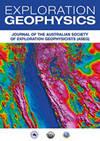Application of model-based acoustic impedance inversion in the prediction of thin interbedded coal seams: a case study in the Yuwang colliery, Yunnan Province
IF 0.8
4区 地球科学
Q4 GEOCHEMISTRY & GEOPHYSICS
引用次数: 0
Abstract
The Permian coal seams in eastern Yunnan and western Guizhou are thin, numerous, and staggered with other thin coal seams. Depicting the fine characteristics of coal reservoirs is pivotal for the safe and efficient exploitation of coal and coalbed methane (CBM), and is important for transparent mining. To improve the inverse resolution and accuracy of predicting reservoir thickness, this study used the model-based acoustic impedance (AI) inversion method that utilizes seismic and logging data. This method changes seismic data, reflecting stratigraphic interfaces, into AI data, reflecting lithologic structures. Moreover, it avoids the relevant assumptions of wavelets and reflection coefficients. Compared with other inversion methods, model-based AI inversion strengthens the description of thin reservoir horizontal and vertical changes. The results showed that comprehensively using intermediate-frequency seismic information and high-low-frequency logging data greatly broadens the seismic data frequency band and improves the dominant frequency of the reflected wave. Furthermore, the AI profile resolution and the prediction accuracy of the physical parameters for the target geological body can be improved. A cross-validation comparing the inverted thickness and measured thickness of borehole cores was applied to achieve fine prediction (error of appropriately 0.02–0.4 m), providing a basis for CBM development.基于模型的声阻抗反演在薄互层煤层预测中的应用——以云南玉王煤矿为例
滇东、黔西二叠统煤层薄、多,与其他薄煤层交错分布。描述煤储层的精细特征是安全高效开采煤炭和煤层气的关键,也是透明开采的重要内容。为了提高储层厚度预测的反演分辨率和精度,本研究使用了基于模型的声阻抗反演方法,该方法利用了地震和测井数据。该方法将反映地层界面的地震数据转换为反映岩性结构的AI数据。此外,它避免了小波和反射系数的相关假设。与其他反演方法相比,基于模型的AI反演加强了对薄储层水平和垂直变化的描述。结果表明,综合利用中频地震信息和高低频测井资料,大大拓宽了地震资料的频带,提高了反射波的主频。此外,可以提高目标地质体的AI剖面分辨率和物理参数的预测精度。应用交叉验证,比较钻孔岩芯的反演厚度和测量厚度,以实现精细预测(误差为0.02–0.4 m) ,为煤层气开发提供了基础。
本文章由计算机程序翻译,如有差异,请以英文原文为准。
求助全文
约1分钟内获得全文
求助全文
来源期刊

Exploration Geophysics
地学-地球化学与地球物理
CiteScore
2.30
自引率
0.00%
发文量
33
审稿时长
>12 weeks
期刊介绍:
Exploration Geophysics is published on behalf of the Australian Society of Exploration Geophysicists (ASEG), Society of Exploration Geophysics of Japan (SEGJ), and Korean Society of Earth and Exploration Geophysicists (KSEG).
The journal presents significant case histories, advances in data interpretation, and theoretical developments resulting from original research in exploration and applied geophysics. Papers that may have implications for field practice in Australia, even if they report work from other continents, will be welcome. ´Exploration and applied geophysics´ will be interpreted broadly by the editors, so that geotechnical and environmental studies are by no means precluded.
Papers are expected to be of a high standard. Exploration Geophysics uses an international pool of reviewers drawn from industry and academic authorities as selected by the editorial panel.
The journal provides a common meeting ground for geophysicists active in either field studies or basic research.
 求助内容:
求助内容: 应助结果提醒方式:
应助结果提醒方式:


